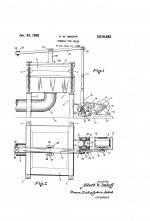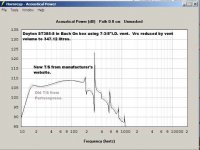I'd love to see a reference on that, to see how it was done. I have somewhere seen reference to ranking paired but detuned pipes, so the beat produces a tremolo effect. Never heard or seen it though (and definitely off-topic here, since you'd never see it on a 32' stop 😉).
Unda Maris
Is probably what you are referring to.
Yes it is still done. I'm trying to find a picture on Google without having to resort to scanning a book on my shelf!
And a pic.
More modern but the principle is there. A Tremulant, Tremolo, Schwebung are some of the names given for this type of a device.
It moderates the air pressure by means of a small bellows that is opened and closed slightly. In times past it was totally air driven. The pic shows a small electric motor driving it.

More modern but the principle is there. A Tremulant, Tremolo, Schwebung are some of the names given for this type of a device.
It moderates the air pressure by means of a small bellows that is opened and closed slightly. In times past it was totally air driven. The pic shows a small electric motor driving it.

I've taken the T/S parameters from the manufacturer's website:Hi Y'all,
I'm enjoying the discussion about organs and music. Thank you.
I have a question for Icsaszar though:
Which driver are you using in your simulation from Post #452?
From the manufacturer's data sheet for the Dayton ST385, and using Hornresp recalculation feature I get:
fs = 18.80 hertz
Qes = 0.33
Qms = 8.31
Vas = 300.90 litres
Qts = 0.32
the rest you can see from the Input screen in my simulation, e.g.: Post #434.
Just trying to make sure that I have the correct T/S parameters.
Small variations should not matter, but you have a considerably larger Vas=545litres, and a lower fs=15.46, that's too much of a difference for my liking.
Regards,
http://www.daytonaudio.com/index.php/st385-8-15-series-ii-woofer.html
Hi Icsaszar,
Thanks for the link.
I compared both in Hornresp, and the difference is smaller than I thought. I reduced the internal volume to 347.12 litres [12.258ft^3] to make up for the lost vent volume of 21 litres.
Regards,
So what is the practical take home I am to learn from this sim?
Bach On
Hi Bach On,
The sim in Post #467 shows that the different T/S parameters provided by the manufacturer, and by Partsexpress will both work in your enclosure w/ the 7-3/8"I.D. x 30" long duct.
Also, it is always best to work from measured T/S parameters, but not always possible.
Regards,
The sim in Post #467 shows that the different T/S parameters provided by the manufacturer, and by Partsexpress will both work in your enclosure w/ the 7-3/8"I.D. x 30" long duct.
Also, it is always best to work from measured T/S parameters, but not always possible.
Regards,
Seems likely that's it. The "bellows thingie" is new to me . . .Unda Maris
Is probably what you are referring to.
By that count at least I've had a very good life . . . (and a lot to look forward to . . .)Today is a good day then!
You learned something new.
Hi Y'all,
I thought I improve the notes/sketch (Post #458) just a little bit, especially as pertains to the vent ends. Any bass-reflex vent should have some form of roundover at the ends, and this is the minimal way I have used since the early 1970's. Just a suggestion, but I consider this a minimum.
Regards,
P.S.: If you already finished your modifications, never mind. Maybe next time? 🙂
I thought I improve the notes/sketch (Post #458) just a little bit, especially as pertains to the vent ends. Any bass-reflex vent should have some form of roundover at the ends, and this is the minimal way I have used since the early 1970's. Just a suggestion, but I consider this a minimum.
Regards,
P.S.: If you already finished your modifications, never mind. Maybe next time? 🙂
Attachments
Nicely laid out Oliver.
And a great addition to a simple vent. You just need a router and a big momma round over bit.
Or some patience and determination. And a rasp and sandpaper. There are always more than one way to accomplish something like that.
And a great addition to a simple vent. You just need a router and a big momma round over bit.
Or some patience and determination. And a rasp and sandpaper. There are always more than one way to accomplish something like that.
Nicely laid out Oliver.
And a great addition to a simple vent. You just need a router and a big momma round over bit.
Or some patience and determination. And a rasp and sandpaper. There are always more than one way to accomplish something like that.
One of the reasons I love my slot ports, I usually build them from the back and then use a flush trim on the front panel to expose it..already right there with the router, takes 30 more seconds for a bit change 🙂
Hi DrDyna,
I like slot ports too, and wish I had more time to run actual experiments on slot ports using a combination of the JBL jet port and Polk's power port. But, that ain't gonna happen. 🙂
This particular box would benefit from some adaption of the power port, as referenced in Post #392. It could almost be the little brother of the XXX Ported system @ data-bass. The extension the OP is looking for is similar to that system, that's why I referenced it to show what's involved.
I spend a little more time looking at different drivers, and port exit velocities w/ the OP's box and the 7-3/4"I.D. x 30" long vent:
For his box, and the desired lower and upper extension (16-177Hz), Bach On ended up w/ a decent driver, as a lot of additional excursion will get into the range where the vent exit velocity is too high. Examples are a single JBL GTO1514 (Xmax=14.5mm) will drive the particle velocity to 28.5m/s @ 14.50Hz, or a single UM15-22 (Xmax=19mm) 26.22m/s @ 14.50Hz w/ the given box and 7-3/8"I.D. vent. (The Ultimax 15 has the smoothest frequency response. The UM15-22 would be my choice, same box/vent.) Two ST385s (Xmax=7.9mm) only result in 16.61m/s @ 12.94Hz (that should work well), and a single ST385 gives 12.49m/s @ 14.92Hz, so just a question if the output is loud enough.
Regards,
I like slot ports too, and wish I had more time to run actual experiments on slot ports using a combination of the JBL jet port and Polk's power port. But, that ain't gonna happen. 🙂
This particular box would benefit from some adaption of the power port, as referenced in Post #392. It could almost be the little brother of the XXX Ported system @ data-bass. The extension the OP is looking for is similar to that system, that's why I referenced it to show what's involved.
I spend a little more time looking at different drivers, and port exit velocities w/ the OP's box and the 7-3/4"I.D. x 30" long vent:
For his box, and the desired lower and upper extension (16-177Hz), Bach On ended up w/ a decent driver, as a lot of additional excursion will get into the range where the vent exit velocity is too high. Examples are a single JBL GTO1514 (Xmax=14.5mm) will drive the particle velocity to 28.5m/s @ 14.50Hz, or a single UM15-22 (Xmax=19mm) 26.22m/s @ 14.50Hz w/ the given box and 7-3/8"I.D. vent. (The Ultimax 15 has the smoothest frequency response. The UM15-22 would be my choice, same box/vent.) Two ST385s (Xmax=7.9mm) only result in 16.61m/s @ 12.94Hz (that should work well), and a single ST385 gives 12.49m/s @ 14.92Hz, so just a question if the output is loud enough.
Regards,
Some organ pipes can produce pitches down to 16 hz. for the lowest pitch. These pipes aren't used all the time. But they are often used when the organ is already being played loudly. I would not need these sounds every week, but I might need them six or seven times a year. (BTW, there is even an organ pipe that can play down to 8 hz. We have no interest in going that low.)
Bach On
I have an "unusual" LP of organ music (I think, Bach's). On side B there are 3 tracks which - according to the sleeve notes - are of 3 organ pipes, delivering 16Hz, 12Hz ... and 8Hz (64' pipe)!
Of course, on all 3 of these, not a sound comes from my speakers (although I can plainly see the cantilever wiggling hugely from side to side)! 🙁
 However, at the end of the year, I am adding 2x 15" subs to my Maggies, so I look forward to whether I'll be able to hear the 16Hz tone as a result! 🙂
However, at the end of the year, I am adding 2x 15" subs to my Maggies, so I look forward to whether I'll be able to hear the 16Hz tone as a result! 🙂Regards,
Andy
8hz on an LP. Now that would be one difficult record to cut, and play back!
It's only about a minute of sound - obviously, the grooves are spaced very widely apart! 😱
Andy
Fundamentally (ha ha) silly. It would accomplish nothing from the beginning to the end of the reproduction chain except overload and increased distortion, and in most cases (equipment) it would be filtered out to avoid just those problems.8hz on an LP. Now that would be one difficult record to cut
I really wonder how many phono amps even operate that low down. It's really wow and flutter territory.
Killed by a rumble filter.
Killed by a rumble filter.
- Status
- Not open for further replies.
- Home
- Loudspeakers
- Subwoofers
- 16Hz for church organ
